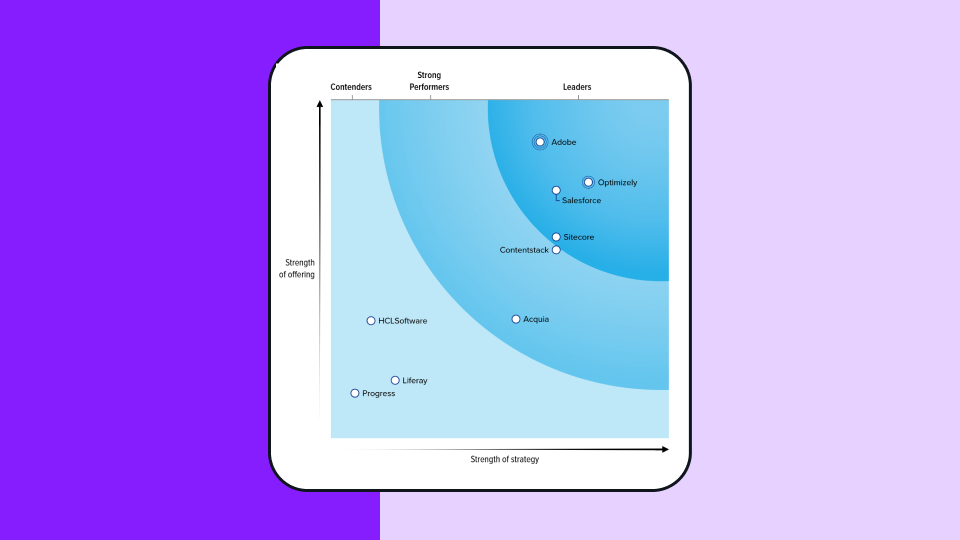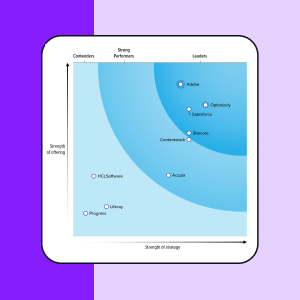Verwaltung digitaler Inhalte
Was ist digitales Content Management?
Digital Content Management (DCM) ist eine Reihe von Prozessen, die es Unternehmen ermöglichen, die Content-Erstellung, -Zuweisung und -Verbreitung digitaler Inhalte zu optimieren.
Eine effiziente Verwaltung der digitalen Inhalte eines Unternehmens ist für einen erfolgreichen Geschäftsbetrieb unerlässlich. Sie und Ihre Teammitglieder sollten sich DCM wie eine Art Superhelden-Bibliothekar vorstellen, der Ihr digitales Kapital verwaltet und schützt. 🦸
Was ist digitaler Inhalt und wie kann er verwaltet werden?
Es gibt heute zwei allgemeine Arten von Systemen zur Verwaltung digitaler Inhalte: Digital Asset Management (DAM) und Content Management Systeme (CMS).
Systeme zur Verwaltung digitaler Assets
Interne digitale Inhalte müssen organisiert und indiziert werden, um einen effizienten Geschäftsbetrieb zu ermöglichen. Außerdem müssen sie sicher sein.
DAM-Systeme werden häufig für die interne Verwaltung digitaler Daten eingesetzt, insbesondere für die Verwaltung von Inhalten in ihrer reinsten Form - Blaupausen, Rohvideo, Audiodateien, Entwürfe.
Hier sind einige Beispiele für die verschiedenen Arten von Inhalten, für die digitale Inhalte oder DAM-Systeme verwendet werden:
- HR-Dateien und Branding-Vorlagen
- Geschäftsverträge und Präsentationen
- Handbücher und Videos für Mitarbeiterschulungen
- Rohe Forschungsdaten
- Proprietäre Design-Dateien
Sehen Sie sich unsere kurze Demo von Optimizely Digital Asset Management an, um es in Aktion zu erleben.
Digitale Content Management Systeme (CMS)
Content Management Systeme sind allgegenwärtig, wenn es darum geht, externe, für die Öffentlichkeit bestimmte Inhalte zu verwalten (z.B. Assets für Websites, soziale Medien und Mobile Apps). Vielleicht sind Sie bereits mit mehreren Content Management Systemen vertraut, ohne es zu wissen - z.B. ist WordPress ein CMS, auf dem über 43% aller Websites basieren.
CMS sind sehr effizient bei der Organisation digitaler Assets für die öffentliche Weitergabe - jetzt oder in Zukunft. CMS-Inhalte umfassen in der Regel digitale Assets, die sich auf Marketing-Teams, den Vertrieb und den Kundensupport beziehen.
Zu den öffentlich zugänglichen digitalen Medien oder Inhalten, die typischerweise in einem CMS zu finden sind, gehören:
- Produktinformationen
- Fotos und Videos
- Inhalte für soziale Medien
- Blogs, eBooks, Weißbücher
- Website Assets
Ein CMS kann auch interne Inhalte verwalten. Viele Unternehmensintranets werden mit einem CMS statt mit einem DAM erstellt.
Die Prozesse hinter dem digitalen Content Management
Digitales Content Management ist mehr als eine Softwarelösung; es ist ein Zyklus automatisierter Prozesse zur Unterstützung der Multimedia- und Dokumentenverwaltung. Die Software, die Sie für die Verwaltung Ihrer digitalen Inhalte wählen, trägt lediglich zur Effizienz dieses Zyklus bei.
Verschiedene Modelle wurden von Forschern und Unternehmen entwickelt, um den Zyklus des digitalen Content Management zu beschreiben. Sie alle verlaufen parallel zum Lebenszyklus der Inhalte, wenn auch mit leichten Abweichungen.
-
Importieren oder Erstellen digitaler Inhalte
Digitaler Inhalt beginnt mit der Erstellung. Der Content Manager erstellt entweder Inhalte oder erwirbt sie. Unabhängig davon beginnt der Prozess der Verwaltung digitaler Inhalte, wenn der Inhalt zum ersten Mal instanziiert und in der Datenbank des Verwaltungssystems gespeichert wird.
Sie können Inhalte auf der Grundlage einer Reihe von Attributen klassifizieren, die später ins Spiel kommen. Es empfiehlt sich, bestimmte Namenskonventionen und Protokolle für die Erstellung von Inhalten festzulegen, bevor Sie mit dem Importieren oder Erstellen neuer digitaler Assets beginnen. -
Identifizieren Sie Benutzer und Rollen
Wer werden die verschiedenen Benutzer sein, die Ihre Inhalte erstellen - sowohl intern als auch auf der öffentlichen Seite?
Die Verwaltung digitaler Inhalte ist immer ein gemeinschaftlicher Prozess, bei dem Menschen während des gesamten Lebenszyklus mit den Inhalten interagieren - vom Videofilmer bis zum Videostreamer.
Die besten digitalen CMS-Lösungen befähigen alle fünf Benutzerrollen: -
Content Creators und Content Marketing Manager:
Sie sind für die Erstellung, den Import und die Bearbeitung digitaler Inhalte verantwortlich. -
Redakteure:
Sie sind nicht für die Rohschnittbearbeitung zuständig, sondern überwachen die Botschaft und den Stil, um den unterschiedlichen Bedürfnissen der verschiedenen Inhaltskonsumenten gerecht zu werden (z.B. Übersetzung, Lokalisierung). -
Verleger:
Legt fest, wann und für wen er die Inhalte zur Verwendung freigibt. -
Administratoren:
Verwaltet Benutzer, Gruppen, Rollen und den Zugriff auf digitale Inhalte. Der Gatekeeper für alle digitalen Inhalte oder in vielen Fällen für bestimmte Bereiche digitaler Inhalte (z. B. Videos, Blogs, Bilder). -
Verbraucher:
Die Person, die den digitalen Inhalt konsumiert, sobald er geteilt wird. In der Regel handelt es sich dabei um eine Person außerhalb des Unternehmens - eine Online-Website in der E-Commerce-Branche oder ein App-Nutzer. Es kann sich auch um einen Mitarbeiter handeln, wenn das System für die Verwaltung interner digitaler Inhalte eingerichtet wurde. -
Zuweisung von Rollen und Verantwortlichkeiten
Administratoren können Gruppen erstellen, um Benutzern, die dieselben Aufgaben betreuen, Berechtigungen zu erteilen. Den Benutzern werden Rollen zugewiesen, um sicherzustellen, dass digitale Inhalte während ihres gesamten Lebenszyklus verwaltet werden. Die Verantwortlichkeiten für Inhalte müssen für Benutzer in verschiedenen Rollen festgelegt werden, um die Integrität und Sicherheit der Daten zu gewährleisten. -
Definieren Sie Workflow-Prozesse
In dieser Phase wird das Content Management zum Projektmanagement. Der Workflow wird mit Hilfe eines CMS oder DAM automatisiert. Die Prozesse für die Verwaltung, Verfolgung und Vermittlung digitaler Inhalte müssen jedoch festgelegt werden. Für die Projektüberwachung können verschiedene CMS eingerichtet werden. -
Versionsverfolgung und -verwaltung
Digitale Inhalte durchlaufen fast immer einen iterativen Entwicklungsprozess. Die Versionsverfolgung und die Verwaltung von Inhaltsänderungen sind wichtige Bestandteile des Inhaltsmanagements. CMS und DAMs sollten dies standardmäßig tun. Vergessen Sie nicht, ein System für die Nachverfolgung von Änderungen einzurichten, wenn Sie Ihr CMS von Grund auf selbst entwickeln. -
Veröffentlichen, um Zugang zu gewähren
Der Herausgeber muss in der Lage sein, digitale Inhalte zu veröffentlichen, sobald diese für die Welt - oder Ihr Unternehmen - bereit sind. Die Veröffentlichung ist die letzte Phase der generischen Content-Erstellung. Heutzutage sehnen sich Kunden und Website-Besucher jedoch nach Personalisierung. -
Personalisieren Sie Inhalte auf der Grundlage des Benutzers
Customer Journeys und die Personalisierung digitaler Inhalte werden wichtiger denn je, um Kunden zu gewinnen und Markentreue aufzubauen. Die besten CMS ermöglichen es Ihnen, die Inhalte, die verschiedenen Benutzern angezeigt werden, zu personalisieren und zu personalisieren. Wissen Sie zum Beispiel, dass der Besucher ein Mann ist, der sich für Drachenfliegen interessiert? Dann können Sie Ihr CMS veranlassen, aus allen Bildern in Ihrer Datenbank, die einen blauen Himmel zeigen, ein Header-Bild auszuwählen. -
Archivieren oder löschen Sie digitale Inhalte
Die Möglichkeit, alte Inhalte zu archivieren, ist von entscheidender Bedeutung. Das spart Speicherplatz und macht die CMS- und DAM-Verarbeitung effizienter. Manchmal möchten Sie vielleicht Inhalte löschen - oft aus Gründen, die am besten nicht genannt werden (z.B. Urheberrechtsverletzungen, negative Reaktionen in den sozialen Medien auf ein Video). Jedes digitale Content Management System muss diese beiden Dinge können.
Serverbasiertes VS. Cloud-basiertes digitales Content Management
Digitales Content Management ist ein Muss für jedes Unternehmen, das Inhalte im Web, in sozialen Medien oder in Form von Mobile Apps bereitstellt. Content Management Systeme werden auf zwei verschiedenen Installationsarten betrieben, und die von Ihnen gewählte Installation hat Auswirkungen darauf, wie viele digitale Inhalte Sie effizient bereitstellen können.
Vor-Ort-Installationen werden von Servern aus betrieben - entweder in den Räumlichkeiten des Unternehmens oder über einen Hosting-Anbieter. Der Platz und die Effizienz dieser Verwaltungssysteme sind begrenzt und abhängig von der Qualität der Serversoftware.
Cloud-basierte CMS-Dienste bieten eine erstaunlich schnelle Verarbeitung, können nach Bedarf skaliert werden und sind unempfindlich gegenüber Stromausfällen und anderen Horrorgeschichten aus dem Serverraum. Dies kann das Erlebnis des digitalen Marketings verbessern, und wie wir immer sagen: je besser das Erlebnis der Marketer, desto besser das Erlebnis der Kunden. Es scheint alles durch.
Die Wahl des richtigen digitalen Content Management Systems für Sie
Bevor Sie sich für ein digitales Content Management System entscheiden, sollten Sie überlegen, welche Installation für Sie am effizientesten und kostengünstigsten ist.
Um Ihnen die Entscheidung zu erleichtern, lesen Sie unseren Leitfaden zur Auswahl eines CMS.

